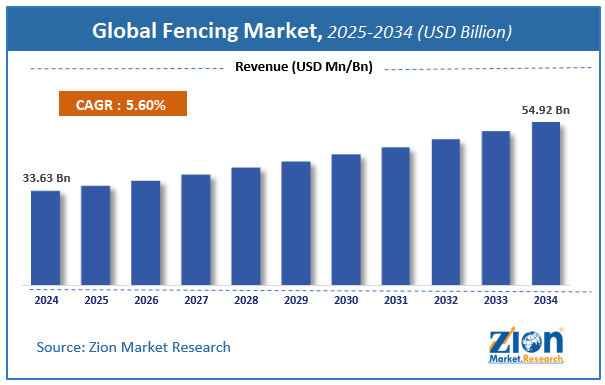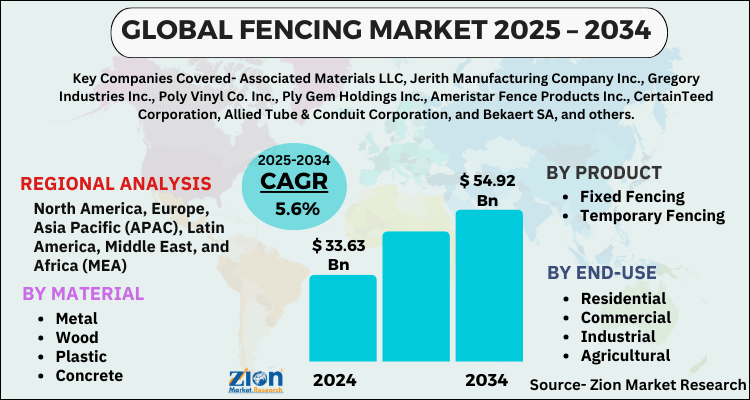Fencing Market Size, Share & Trends Analysis Report, 2034

Fencing Market By Material (Metal, Wood, Plastic, Concrete, & Others), By Products (Fixed Fencing, & Temporary Fencing), By End-Use (Residential, Commercial, Industrial, Agricultural, and Others), and By Region: Global and Regional Industry Overview, Market Intelligence, Comprehensive Analysis, Historical Data, and Forecasts 2025 - 2034
| Market Size in 2024 | Market Forecast in 2034 | CAGR (in %) | Base Year |
|---|---|---|---|
| USD 33.63 Billion | USD 54.92 Billion | 5.6% | 2024 |
Fencing Industry Perspective:
The global fencing market size was worth around USD 33.63 Billion in 2024 and is predicted to grow to around USD 54.92 Billion by 2034 with a compound annual growth rate (CAGR) of roughly 5.6% between 2025 and 2034. The report analyzes the global fencing market's drivers, restraints/challenges, and the effect they have on the demands during the projection period. In addition, the report explores emerging opportunities in the fencing industry.
This report discusses market research on the fencing market, its market growth factors, and its challenges. The report also talks about the opportunities available to stakeholders, researchers, and potential investors for the fencing market, discussing the recent changes due to the pandemic.
Fencing Market: Overview
Fences are detachable additional constructions that are manufactured and meant to prevent strangers from breaching a traditional border. A fence is differentiated from a wall by its strength; typically, a fence is weaker than a wall. Privacy fencing is used to keep unwanted visitors and livestock outside the venue, stylish fencing is used to improve the artistic attractiveness of the property, temporary fencing is used to provide control & safety access to building sites, and boundary fencing is used to differentiate property boundaries.
Key Insights
- As per the analysis shared by our research analyst, the global fencing market is estimated to grow annually at a CAGR of around 5.6% over the forecast period (2025-2034).
- Regarding revenue, the global fencing market size was valued at around USD 33.63 Billion in 2024 and is projected to reach USD 54.92 Billion by 2034.
- The fencing market is projected to grow at a significant rate due to rising security concerns and infrastructure development.
- Based on Material, the Metal segment is expected to lead the global market.
- On the basis of Products, the Fixed Fencing segment is growing at a high rate and will continue to dominate the global market.
- Based on the End-Use, the Residential segment is projected to swipe the largest market share.
- Based on region, North America & Europe is predicted to dominate the global market during the forecast period.
Fencing Market: Growth Drivers
Growth in middle-class population increases the demand for fences all over the world
The rise of the middle class is supporting the expansion of the fencing business. The emerging middle class is anticipated to rise to 5.5 billion people by 2030, as per the European Commission. Asians will make up 87 percent of the increased middle-class population. The rise of the fencing market is being fueled by rising house construction and a comeback in building completions.
Growth in the estate market as a result of an increment in the number of businesses and increased investment in the building industry is also contributing to the growth of the global fencing market.
Fencing Market: Restraints
Fluctuating fence prices and unstable economic conditions due to COVID-19 pose a threat to market
Raw material costs are fluctuating continuously due to unstable economic conditions all over the world due to the pandemic and lockdowns. Metals used in fencing have become more expensive in several parts of the world. When the economy reopened and recovered from the over-a-year-long COVID-19 epidemic, the cost of goods such as aluminum, wood, and others had risen drastically. Economic activity in the global fencing market also slowed as a result of the epidemic.
Fencing Market: Opportunities
Increased use of electric fencing to seal international borders and for agricultural purposes to provide growth opportunities
Electric fence is being used by many military forces throughout the world to deter incursion near international boundaries. Over the disputed border with India, China's military services prefer to lay down spiked electric wires in the Ladakh valley. To safeguard the China-Russia border, Russia's militaries installed an electric fence. As a result, market development is expected to be aided by the increased focus on national security. An electric fence is far more impactful for farm safety since it prohibits wild animals from entering without permission. The industry is expected to grow as farm owners increasingly use electric fences to protect their land from animals in the wild.
Fencing Market: Challenges
High prices associated with the upgradation & maintenance of electric fences pose a challenge
The high price of upgrades and maintenance associated with replacing traditional electric fences makes it difficult to conduct frequent inspections to ensure optimal performance. Its expansion is hampered by hefty maintenance expenses. Farmers are seeking other solutions, like unmanned stems, to offset the high fixed costs linked with the necessity to deploy barriers over international boundaries, which may stifle market expansion.
Fencing Market: Segmentation Analysis
The global fencing market may be divided into four categories based on material: plastic fences, metal fences, concrete fences, wood fences, and other. Metal fence is by far the most popular material in the worldwide fencing industry. Due to its long-term reliability and low maintenance and repair needs, the plastic fence category is anticipated to rise at the highest pace in the future years. Composite, vinyl, and high-density polyethylene (HDPE) fences are examples of this type.
Based on the product, the fence can be divided as temporary and permanent, where the temporary segment is expected to depict a steady rise in the forecast period.
Based on the end-user, the fencing market has been segmented into residential, commercial, industrial, agricultural, and others. Throughout the projection period, residential is expected to be the most popular application category and is likely to rise due to an increase in building and renovation activity. Moreover, increased disposable income combined with increasing consumer attention to home repair activities is anticipated to fuel demand for residential fences over the period.
Fencing Market: Report Scope
| Report Attributes | Report Details |
|---|---|
| Report Name | Fencing Market |
| Market Size in 2024 | USD 33.63 Billion |
| Market Forecast in 2034 | USD 54.92 Billion |
| Growth Rate | CAGR of 5.6% |
| Number of Pages | 150 |
| Key Companies Covered | Associated Materials LLC, Jerith Manufacturing Company Inc., Gregory Industries Inc., Poly Vinyl Co. Inc., Ply Gem Holdings Inc., Ameristar Fence Products Inc., CertainTeed Corporation, Allied Tube & Conduit Corporation, and Bekaert SA, and others. |
| Segments Covered | By Material, By Products, By End-Use, and By Region |
| Regions Covered | North America, Europe, Asia Pacific (APAC), Latin America, The Middle East and Africa (MEA) |
| Base Year | 2024 |
| Historical Year | 2020 to 2023 |
| Forecast Year | 2025 - 2034 |
| Customization Scope | Avail customized purchase options to meet your exact research needs. Request For Customization |
Recent Developments
- In 2019, several companies such as JVA technologies introduced a new product in the market, based on electric fencing with IoT systems. One of the most prominent products was Jumbo Electric Fence Energizer series which includes a whole CPU unit with a monitor and keyboard for control, and can be connected top devices through Wi-Fi.
- In 2021, two major companies in the fencing industry namely, Datamars SA and Cabi Group collaborated together as partners to increase the market of Speedrite Electric fencing in France.
Fencing Market: Regional Landscape
Europe and North America lead the global fencing market followed by Asia Pacific.
Over the forecast period, Europe and North America are expected to be the most important regions. The regional market is expected to develop as building activities increase and demand for ornamental home items rises. In 2021, the North American region amounted to about 40.0 percent of the total market. The middle-class demographic in these regions is predicted to invest in over 75.0 percent of global fence purchases.
Due to the expanding agricultural sector of rising nations such as India and China, the Asia Pacific region is expected to gain momentum throughout the forecast period. India's urban growth and rising investment in infrastructure reforms are likely to boost the market in the region.
Fencing Market: Competitive Landscape
Given the prominence of top global companies in the fencing industry, starting new businesses becomes tough. Though collaborations with these companies might be beneficial to small players, new investors can invest in the supply chain of the fencing industry for profit.
Some well-known companies in the global fencing market are
- Associated Materials LLC
- Jerith Manufacturing Company Inc.
- Gregory Industries Inc.
- Poly Vinyl Co. Inc.
- Ply Gem Holdings Inc.
- Ameristar Fence Products Inc.
- CertainTeed Corporation
- Allied Tube & Conduit Corporation
- Bekaert SA.
The global fencing market is segmented as follows:
By Material
- Metal
- Wood
- Plastic
- Concrete
- Others
By Product
- Fixed Fencing
- Temporary Fencing
By End-Use
- Residential
- Commercial
- Industrial
- Agricultural
- Others
By Region
- North America
- The U.S.
- Canada
- Mexico
- Europe
- France
- The UK
- Spain
- Germany
- Italy
- Rest of Europe
- Asia Pacific
- China
- Japan
- India
- Australia
- South Korea
- Rest of Asia Pacific
- The Middle East & Africa
- Saudi Arabia
- UAE
- Egypt
- Kuwait
- South Africa
- Rest of the Middle East & Africa
- Latin America
- Brazil
- Argentina
- Rest of Latin America
Table Of Content
Methodology
FrequentlyAsked Questions
The global fencing market is expected to grow due to increasing demand for security and privacy solutions, rising urbanization, and growth in infrastructure development projects.
According to a study, the global fencing market size was worth around USD 33.63 Billion in 2024 and is expected to reach USD 54.92 Billion by 2034.
The global fencing market is expected to grow at a CAGR of 5.6% during the forecast period.
North America & Europe is expected to dominate the fencing market over the forecast period.
Leading players in the global fencing market include Associated Materials LLC, Jerith Manufacturing Company Inc., Gregory Industries Inc., Poly Vinyl Co. Inc., Ply Gem Holdings Inc., Ameristar Fence Products Inc., CertainTeed Corporation, Allied Tube & Conduit Corporation, and Bekaert SA, among others.
The report explores crucial aspects of the fencing market, including a detailed discussion of existing growth factors and restraints, while also examining future growth opportunities and challenges that impact the market.
RelatedNews
HappyClients
Zion Market Research
Tel: +1 (302) 444-0166
USA/Canada Toll Free No.+1 (855) 465-4651
3rd Floor,
Mrunal Paradise, Opp Maharaja Hotel,
Pimple Gurav, Pune 411061,
Maharashtra, India
Phone No +91 7768 006 007, +91 7768 006 008
US OFFICE NO +1 (302) 444-0166
US/CAN TOLL FREE +1 (855) 465-4651
Email: sales@zionmarketresearch.com
We have secured system to process your transaction.
Our support available to help you 24 hours a day, five days a week.
Monday - Friday: 9AM - 6PM
Saturday - Sunday: Closed






